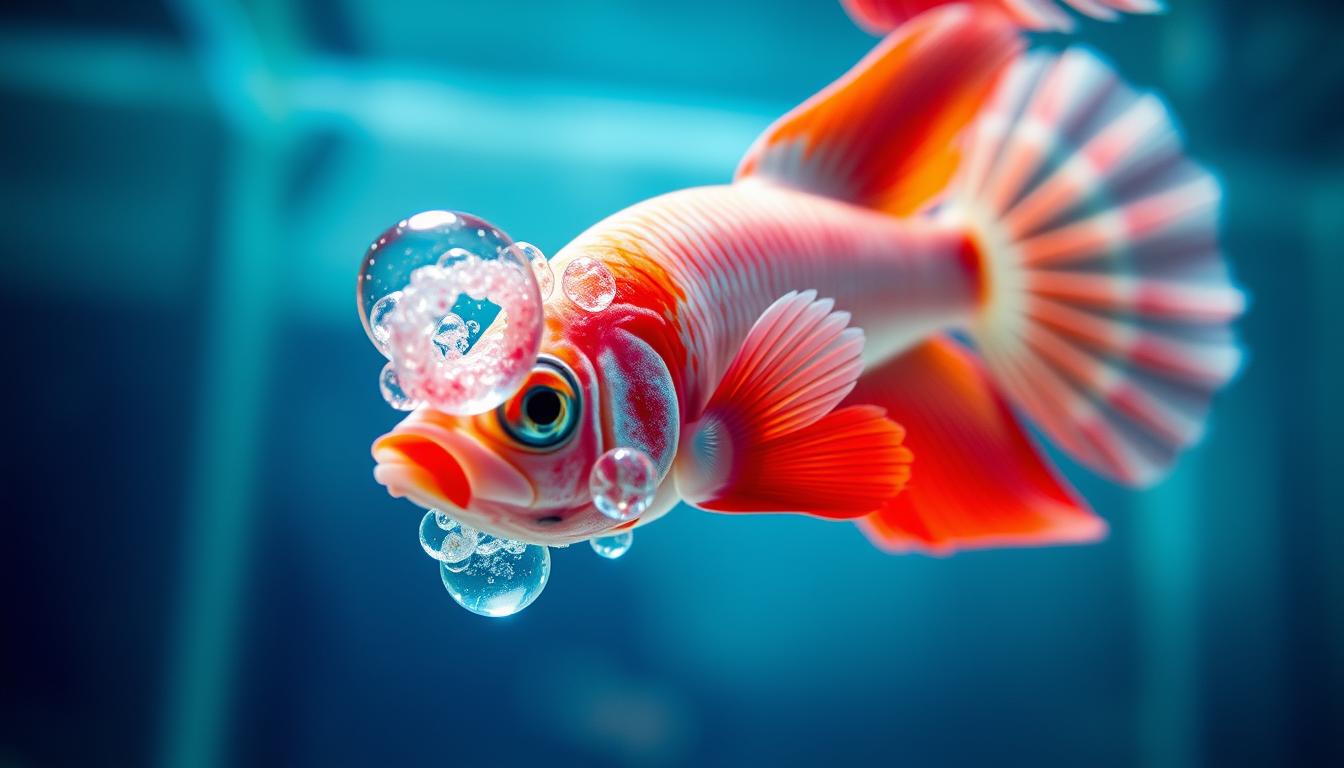Have you ever seen your betta fish floating awkwardly or stuck near the surface like a tiny balloon? It might be more serious than it looks — your fish could be suffering from gas bubble disease in betta fish.
This lesser-known condition can affect your betta’s swim bladder, gills, and even their skin. In this guide, we’ll explain what causes gas bubble disease, how to spot the early warning signs, and what steps you can take to cure and prevent it. Whether you’re a beginner or a seasoned betta owner, this guide will help you keep your fish healthy and stress-free.
If you own a betta fish, knowing about gas bubble disease is key. We’ll cover the causes, symptoms, and treatments. This way, you can keep your pet healthy and happy.
Read Also Can Betta Fish Die from Swim Bladder Disease? The Truth Every Owner Must Know!
Key Takeaways
- Understand the causes of gas bubble disease in betta fish
- Recognize the symptoms to identify the issue early
- Learn effective treatment options for gas bubble disease
- Discover preventive measures to keep your betta fish healthy
- Explore tips for maintaining optimal water quality
Understanding Gas Bubble Disease
Gas bubble disease is a condition that can harm betta fish. It causes symptoms that worry aquarium owners. So, what is it, and how can you spot it in your betta fish?
What Is Gas Bubble Disease?
Gas bubble disease happens when water has too much gas. This gas forms bubbles in the fish’s body and blood. It can be triggered by sudden water temperature or pressure changes.
How It Affects Betta Fish Specifically
Betta fish are more likely to get gas bubble disease. They have a special organ that lets them breathe air. But this makes them more sensitive to water pressure and gas levels.
Prevalence and Risk Factors
Gas bubble disease can happen in any tank. But some things make it more likely. These include bad water quality, not keeping the tank clean, and problems with equipment. Here are some important facts:
| Risk Factor | Prevalence | Impact on Betta Fish |
|---|---|---|
| Poor Water Quality | High | Increases susceptibility to gas bubble disease |
| Inadequate Maintenance | Medium | Can lead to equipment failure and gas supersaturation |
| Equipment Issues | Low | Can cause sudden changes in water pressure and gas saturation |
Knowing what causes gas bubble disease helps you prevent it. This way, you can keep your betta fish happy and healthy.
The Science Behind Gas Supersaturation
Ever wondered why betta fish get gas bubble disease? Let’s dive into the science of gas supersaturation! It happens when water can’t hold all the gases it has. This imbalance creates harmful gas bubbles in the water.
Gas Solubility in Water
The amount of gases in water is key to understanding supersaturation. Gases like oxygen and carbon dioxide dissolve in water based on pressure and temperature. When water holds too much gas, it becomes supersaturated.
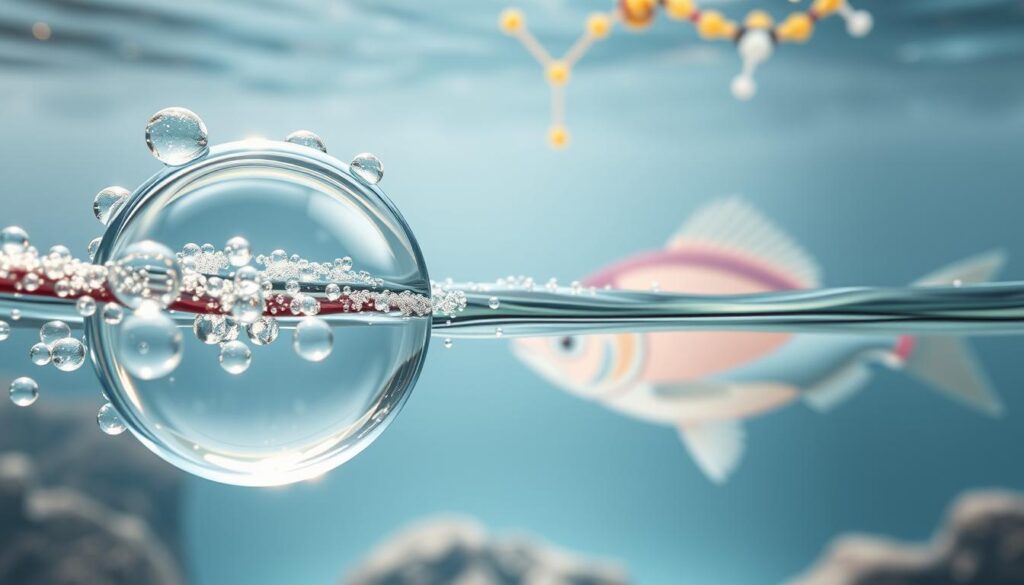
Physiological Impact on Fish
For betta fish, living in supersaturated water is stressful. The extra gases can form bubbles in their bodies. This can cause discomfort, injury, or even death, depending on how long they’re exposed.
Difference Between Gas Bubble Disease and Swim Bladder Disorder
It’s important to know the difference between gas bubble disease and swim bladder disorder. Both affect a fish’s ability to swim, but they have different causes. Gas bubble disease comes from gas supersaturation, while swim bladder disorder can be caused by many things like infections or injuries.
Water Quality and Its Role in Fish Health
The water quality in your betta fish tank is crucial for their health. As a betta fish owner, it’s key to keep the water conditions right. This ensures your fish stay healthy and happy.
Ideal Water Parameters for Betta Fish
Betta fish need specific water conditions to stay healthy. The water should be between 76-82°F (24-28°C) and have a pH of 6.5-7.5. Regular water changes are vital to keep these conditions and prevent toxins.
How Poor Water Quality Contributes to Disease
Poor water quality can cause health issues in betta fish, like gas bubble disease. If the water isn’t right, it can hold too much gas. This can cause bubbles in the fish’s body. Keeping the water quality good can prevent this.
Testing and Monitoring Water Conditions
To keep your betta fish healthy, test the water regularly. Check for pH, ammonia, and nitrite levels. A water test kit can spot problems early. This way, you can keep your fish safe from disease.
By following these tips and good betta fish care practices, you can make a healthy home for your fish. Remember, water quality and its role in fish health is very important!
Gas Bubble Disease in Betta Fish: Causes and Risk Factors
Let’s explore the common causes and risk factors of gas bubble disease in betta fish. As a responsible owner, knowing these factors helps keep your betta healthy.
Sudden Temperature Changes
Sudden temperature changes stress your betta fish, making them more likely to get gas bubble disease. Avoid placing your tank near heating or cooling vents, windows, or doors to keep the temperature stable.
Improper Water Changes
Improper water changes can cause gas supersaturation, a main cause of gas bubble disease. Always match the new water’s temperature and chemistry to the tank’s conditions to avoid shocking your fish.
Faulty Equipment Issues
Faulty equipment, like a cracked or loose pipe in your filtration system, is a common cause of gas bubble disease. Regularly check your equipment to make sure it’s working right.
Air Pumps and Filters
Air pumps and filters can cause gas supersaturation if not maintained well. Check your air pump and filter regularly to prevent problems.
Heaters and Temperature Controllers
Heaters and temperature controllers can also contribute to gas bubble disease if they’re not working right. Ensure your heater is appropriate for your tank size and that your temperature controller is set correctly.
Overaeration Problems
Overaeration can lead to too much gas in the water, causing gas bubble disease. Monitor your tank’s aeration and adjust as needed to keep a healthy environment.
| Cause | Risk Factor | Prevention |
|---|---|---|
| Sudden Temperature Changes | Stress on fish | Stable tank placement |
| Improper Water Changes | Gas supersaturation | Match water conditions |
| Faulty Equipment | Gas leaks | Regular equipment checks |
By understanding these causes and risk factors, you can take steps to prevent gas bubble disease in your betta fish. Remember, a healthy environment is crucial for your pet’s well-being!
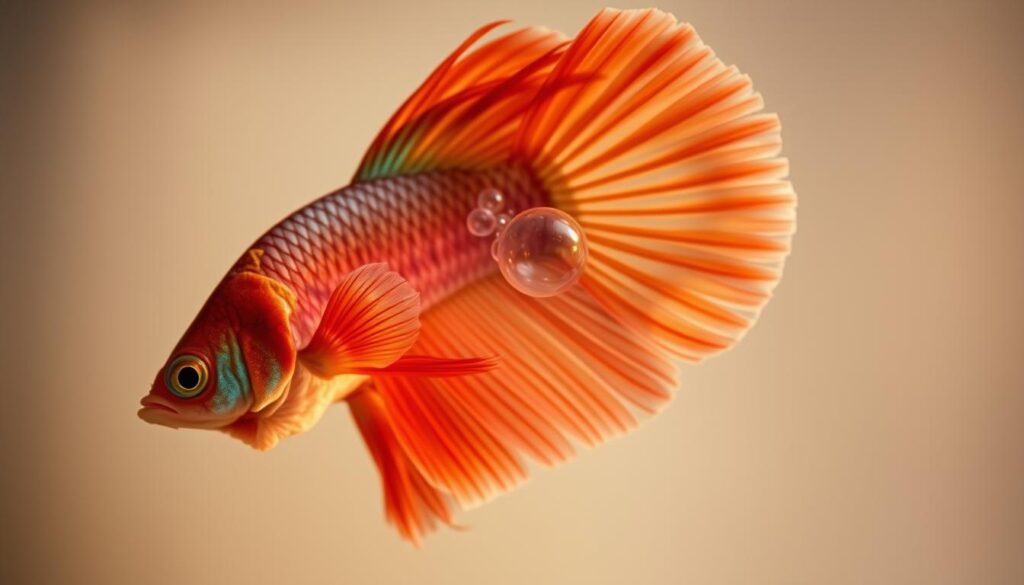
Identifying Symptoms of Gas Bubble Disease
Let’s explore the signs that your betta fish might have gas bubble disease. Spotting these symptoms early can help save your fish.
External Physical Signs
Visible gas bubbles under your betta’s skin are a clear sign. These bubbles can show up in fins and scales.
Visible Gas Bubbles Under Skin
Gas bubbles under the skin can make your betta look different. You might see bubbles in the eyes, on the body, or in the fins. This is a warning sign.
Fin and Scale Abnormalities
Gas bubble disease can also affect your betta’s fins and scales. Fins might look frayed or clamped, and scales could be damaged or stand out.
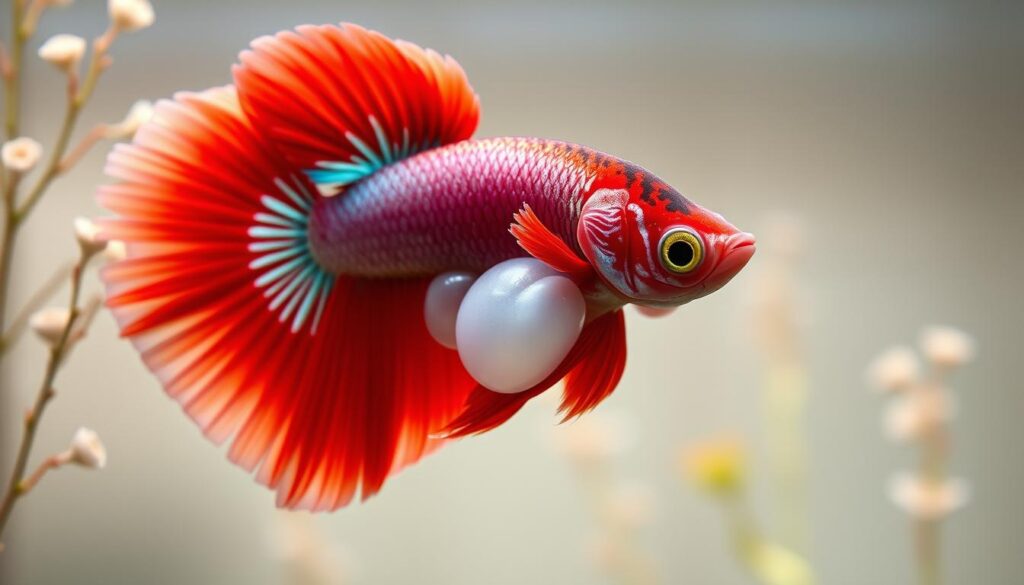
Behavioral Changes
Betta fish with gas bubble disease often act differently. These changes are as important as physical symptoms.
Erratic Swimming Patterns
Affected betta fish might swim erratically. They might dart back and forth or swim near the surface more than usual. This shows they’re uncomfortable or disoriented.
Lethargy and Appetite Loss
Lethargy and less interest in food are common signs. If your betta is usually active and hungry but now seems tired or uninterested in food, it’s a warning.
| Symptom | Description |
|---|---|
| Visible Gas Bubbles | Bubbles under the skin, in eyes, or on fins |
| Fin Abnormalities | Frayed or clamped fins |
| Scale Abnormalities | Standing scales or scale damage |
| Erratic Swimming | Darting or unusual swimming patterns |
| Lethargy | Less active than usual |
| Appetite Loss | Reduced interest in food |
Knowing these symptoms helps you act fast to treat your betta fish. Early action is crucial for their recovery.
Diagnosing Gas Bubble Disease in Aquarium Fish
Figuring out if your aquarium fish has gas bubble disease can be tough. But, with the right steps, you can spot the problem and act fast! As a betta fish owner, knowing the signs is key to caring for your pet.
Visual Examination Techniques
Start by looking closely at your fish. Look for bubbles on their body, fins, or gills. These bubbles might be small, so watch your fish carefully. Also, check if they swim strangely or seem tired.
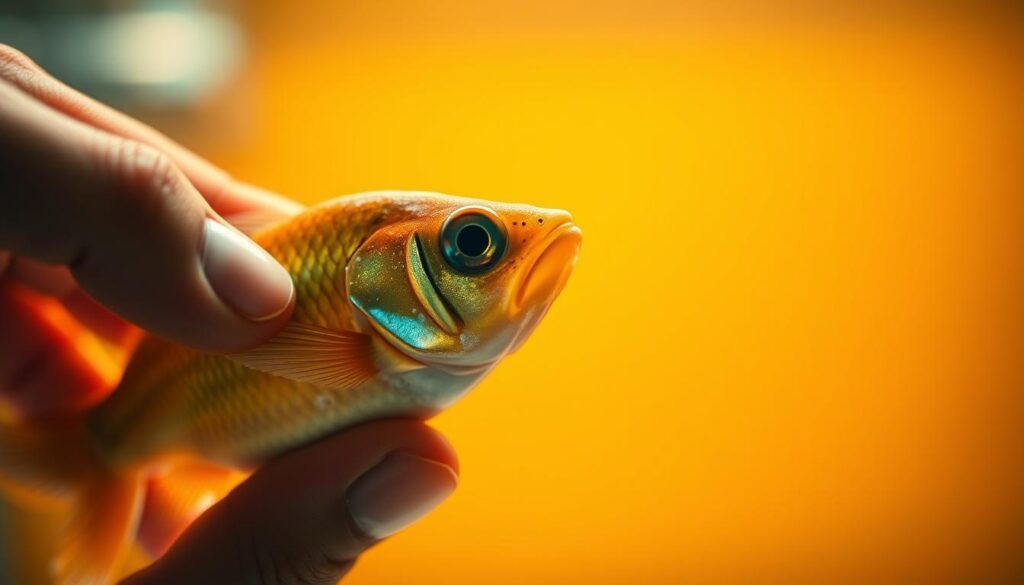
Water Parameter Testing
Testing your water is also important. Check the temperature, pH, and levels of ammonia, nitrite, and nitrate. Use a water test kit to make sure everything is right for your betta fish.
Differential Diagnosis
Make sure to rule out other possible reasons for your fish’s symptoms. Look at other conditions like swim bladder issues or parasites. Talking to a fish expert or vet can help confirm what’s wrong.
When to Consult a Fish Veterinarian
If you’re not sure what’s wrong or if your fish is really sick, see a fish vet! They can do a gill biopsy to find tiny bubbles. Getting professional help is important for your fish’s health.
Treatment Options and Recovery
Betta fish with gas bubble disease need quick help. We’ll show you how to treat and help them recover. First, find and fix the problem that caused the disease.
Immediate Water Parameter Adjustments
To treat gas bubble disease, change your betta fish’s tank water. Lower the water temperature and increase the surface movement. You can do this by adjusting the filter or adding a powerhead.
Medication Options and Considerations
In some cases, medication may be necessary for your betta fish. But, there’s no special medicine for this disease. You can use general aquarium meds to help with stress and healing.
Supportive Care Techniques
Supportive care is key during recovery. Make sure your betta fish is in a calm place. Give them a good diet and watch their health closely.
Recovery Timeline and Expectations
The recovery timeline for betta fish with gas bubble disease varies. Improvements usually start in a few days to a week. Keep watching your fish and adjust treatments as needed.
By following these treatment options and recovery steps, you can help your betta fish get better. They’ll be happy and healthy in their tank again.
Comprehensive Prevention Strategies
To prevent gas bubble disease in betta fish, you need a few key steps. These include setting up your tank right, keeping it clean, and watching your fish closely. By doing these things, you can make sure your betta fish stays healthy and happy.
Proper Tank Setup and Maintenance
Starting with the right tank is important. Pick a tank that’s big enough, use good gravel, and add plants or decorations. These help keep the water moving and full of oxygen. Also, clean the gravel and decorations often to stop debris and bacteria from building up.
Water Change Best Practices
Changing the water in your tank regularly is key. We suggest changing about 25% of the water each week. Use a gravel vacuum to get rid of debris. Make sure the new water is close to the tank’s temperature and chemistry to avoid stressing your fish.
Equipment Selection and Maintenance
Choosing the right equipment is crucial. You’ll need a good filter and a reliable heater to keep the temperature stable. Always check and maintain your equipment to make sure it’s working right.
Regular Monitoring Protocols
It’s important to check your tank’s water often. Use a test kit to check for ammonia, nitrite, and nitrate levels, as well as pH and hardness. Keeping a log of your test results can help you spot any problems early.
Quarantine Procedures for New Fish
When you get new fish, quarantine them first. Set up a separate tank with its own filter and heater. This lets you watch the new fish for any signs of illness before adding them to your main tank.
| Prevention Strategy | Description | Frequency |
|---|---|---|
| Proper Tank Setup | Choose the right tank size and equipment | Initial setup |
| Water Changes | Replace 25% of tank water | Weekly |
| Equipment Maintenance | Check and clean filters and heaters | Monthly |
| Water Parameter Testing | Test for ammonia, nitrite, nitrate, pH, and hardness | Bi-weekly |
| Quarantine New Fish | Observe new fish in a separate tank before introducing to main tank | As needed |
By following these steps, you can greatly lower the chance of gas bubble disease in your betta fish. This will help create a healthy and thriving aquarium environment.
Long-term Care for Affected Betta Fish
The journey doesn’t end when your betta fish recovers from gas bubble disease. In fact, that’s when long-term care begins. Ensuring your betta fish remains healthy requires attention to several key areas.
Post-Recovery Monitoring
After recovery, it’s essential to continue monitoring your betta fish closely. Look for signs of relapse or new issues. Check for symptoms like labored breathing, lethargy, or visible gas bubbles.
Dietary Considerations for Recovery
A balanced diet is crucial for your betta’s ongoing health. Feed high-quality betta pellets or flakes. Also, add live or frozen foods like brine shrimp or bloodworms to enhance nutrition.
Environmental Enrichment
Maintaining a stimulating environment is vital. Ensure your tank is well-planted. Consider adding decorations or toys to keep your betta engaged. Regular water changes and maintaining optimal water parameters are also crucial.
Preventing Recurrence
To prevent gas bubble disease from recurring, avoid sudden changes in water temperature. Ensure proper equipment function and monitor aeration levels. Regularly inspect your tank’s equipment and maintain a stable environment.
By following these guidelines, you can help ensure your betta fish remains healthy. They will thrive after recovering from gas bubble disease.
Conclusion
We’ve looked into gas bubble disease in betta fish, covering causes, symptoms, treatment, and prevention. Knowing the risks and taking steps can help your betta fish stay healthy.
Keeping your tank clean, changing water regularly, and maintaining equipment are key to prevention. If you see symptoms, acting fast can help your betta recover.
Now, you know how to care for your betta fish better. Use this knowledge to create a safe and happy home for your pet. Give your betta the care it needs – it’s worth it!

